Vocabularies of the Visceral and Expressions of Multiple Practices
Jyoti Mistry
How do we write of an African practice, particularly an art practice, that is neither essentialist of an entire continent, nor drawing only from the obvious historical places of a colonial past, and that is, finally, more reflective of the confluences of socio-political and cultural factors informed by access to global trends? More specifically, I mean to suggest that there is a profound tension between what is written and addressed from outside the continent, and the strategies that define those expressions, and how those practices might come to be defined from within. Moreover, the academic discipline-specific needs of the social sciences and even of art critical writing have created a set of paradigmatic principles through which to view practices on the continent (consider, for example, Okwui Enwenzor, Simon Njami and Olu Oguibe).
Using the works of three artists and with reference to specific texts, this study aims to show the multifaceted layers with which a pan-African practice might be produced. This serves as an interventionist approach to the already canonised theories on African art-versus-craft practices. Particularly in the case of the writings on the city of Johannesburg, there has been a tendency to provide theoretical positions from either a strongly historical, an urban development or a social sciences position.
In what has recently been considered an influential publication, Johannesburg, The Elusive Metropolis, a special edition of the journal Public Culture produced by Achille Mbembe and Sarah Nuttall, the authors write: ‘The city’s [Johannesburg] fabric has been described as a structure in need of radical transformation and only rarely as an expression of an aesthetic vision’ (Mbembe & Nuttall 2004: 353). In this analysis I hope to explore the possibilities of an aesthetic vision created from multiple experiences of the city of Johannesburg. Moreover, in addressing the artistic practices of spoken-word artist Kgafela oa Magogodi and filmmakers Akin Omotoso and Nduka Mntambo, I hope to suggest that a pan-African art practice is a modernist project which at once recognises the burden of a colonial historical past and, more significantly, creates multiple entry points for the production of meaning. These entry points offer a counter to assumed notions of what African cities might or might not be (imagined or lived), and gestures towards an art practice and representational form that deals with kaleidoscopic reference points. These reference points are about a search for the meanings of an African experience from within rather than as viewed from outside, or the more conventional concern to offer explicit meanings for an outside audience. The basis of this study, therefore, is an examination of what constitutes these multiple entry points, and how the vast gamut of global literature, cultural and social studies, and indeed evolving African experiences, come to impact on the meanings produced in contemporary African art practices and aesthetics. In developing this study I sought not only to draw on close readings of the films and poetry produced by the three practitioners involved, but chose to engage in a series of conversations with them. Their responses inform or offset my analytical framework and serve as their space to express their influences and experiences of Johannesburg and the making of their work.
The essence of metropolitan culture is change – a state of perpetual animation. (Koolhaas 1994)
All three works considered here – If this be a City (Mntambo 2008), Jesus and the Giant (Omotoso 2008) and Itchy City (oa Magogodi 2006) – express a visceral connection to the city. Each of the works captures a sensory experience, an embodied relation to the space of the city that is dynamic.
The spatial dynamics of Johannesburg after apartheid have resulted in an unstable urban landscape where abandonment and neglect have left once-valued and stable parts of the built environment in decline and ruin, where unbridled growth and horizontal expansion have undermined the Herculean efforts at city planning and regulation, and where the steady expansion of sequestered sites of fantastic luxury has been matched by the proliferation of places of degradation and despair. (Murray 2008: 4)
Nduka Mntambo: Walking in Rosebank, one is confronted with a monumental gaping hole, the construction of the Gautrain. Looking at it from a makeshift pedestrian bridge, I experienced a visceral, almost brutal sensation. The image of a hole for me speaks to the necessary brutality that has to happen in order for cities to stand. The wanton emotional and verbal abuse one has to endure from the city mini-bus taxi drivers and the abject poverty juxtaposed with the meretricious wealth of the African City of the 21st century speaks very strongly to the construction of my precious [golden] ennui.
In his experimental short film If this be a City, Nduka Mntambo captures an intense triangulation between the history of Johannesburg, its aspirational quality – represented through labour and migration – and an urban cosmopolitanism expressed through a single character’s memories and experiences of attempting to fulfil desire and seek love. The film starts with a man alone in a room, in a high-rise apartment building. He is restless, unable to quiet his mind (so it seems), and even though we later learn that the space itself is quiet, sounds from the city invade his cocoon. Not only is he plagued by these sounds, his memories are constantly mediated through the voice of his doppelgänger – a man who is capable of articulating what he himself seems unable to find language for expressing. In his room, in his silence he embodies the city’s alienation, and memories of satisfactory coitus turn into vast spaces of loneliness.
Jyoti Mistry: You describe your film as an expression of a ‘golden ennui’ – how might this be different from urban ennui in any other city where urban alienation, failed dreams and aspirations are so central to the psychological experience of cities?
Nduka Mntambo: The response is at first glance literal. The golden as experienced in my film speaks directly to the object of gold – the reason for the city’s existence which is devoid of any true functionality or substance beyond its glittering surface. Like the object, the very fact that we can have a character drowning in ennui seems to me excessive in the context of our city. The project of imaging this experience of urban alienation, failed dreams and aspiration set in the lofty room overlooking the city evokes an experience quite alien to my experience of the city, which at best can be defined as golden.
What distinguishes this film are the ways in which it moves between the individual experiences of the city, the burden of history and the markers of capital and consumption. Mntambo seems to draw on what Achille Mbembe refers to as the Aesthetics of Superfluity – drawing from Marxist notions of commodity, its relation to (black) migrant culture, and the gold rush that spurred the development of Johannesburg as a city. ‘Through the movement of bodies, superfluity came to be based on not only the prominence of money, credit and speculation but also on the obfuscation of any use value black labour might have had. Such obfuscation was itself a mode of rationality closely related to the circulation of capital. The circulation of capital is predicated not just on class relations but on human investment in certain forms of racial delirium’ (Mbembe 2004: 380).
Mntambo captures this superfluity by rhythmically inter-cutting on a split screen archival images of migrant workers being transported on trucks, a savage butchering of an ox, and cranes against the sky with buildings under construction. In a poignant audio-mix he captures the state of delirium, using the sound of speeding trains and whistles.
But the delirium is not simply about the history of labour (human investment and the circulation of capital). It is also about the way in which this black subject in a post-colonial, post-apartheid state can certainly find expression for desire that is outside of a racialised paradigm (and also possible through economic exchange). The lonely man has lovers of different races, and race seems to have nothing to do with his desire; desire here is non-racialised, produced from availability and access – miscegenation is no longer (institutionally) regulated.
Nduka Mntambo: The lonely man has the luxury of contemplating sexual encounters devoid of human fluids and contact. Is he the kind of a character who drives to Claim Street or Oxford Street at night in search of ‘conversations’ with the ladies of the night? I think coupling speaks very strongly to the conceptual self-flagellation in my reading of the city. There is nothing uniquely or inherently sexual or violent about my African city, yet this representational preoccupation seems to be very pervasive in the discourse about Jo’burg. Hopefully my text begins to contest these preoccupations and presents them as such.
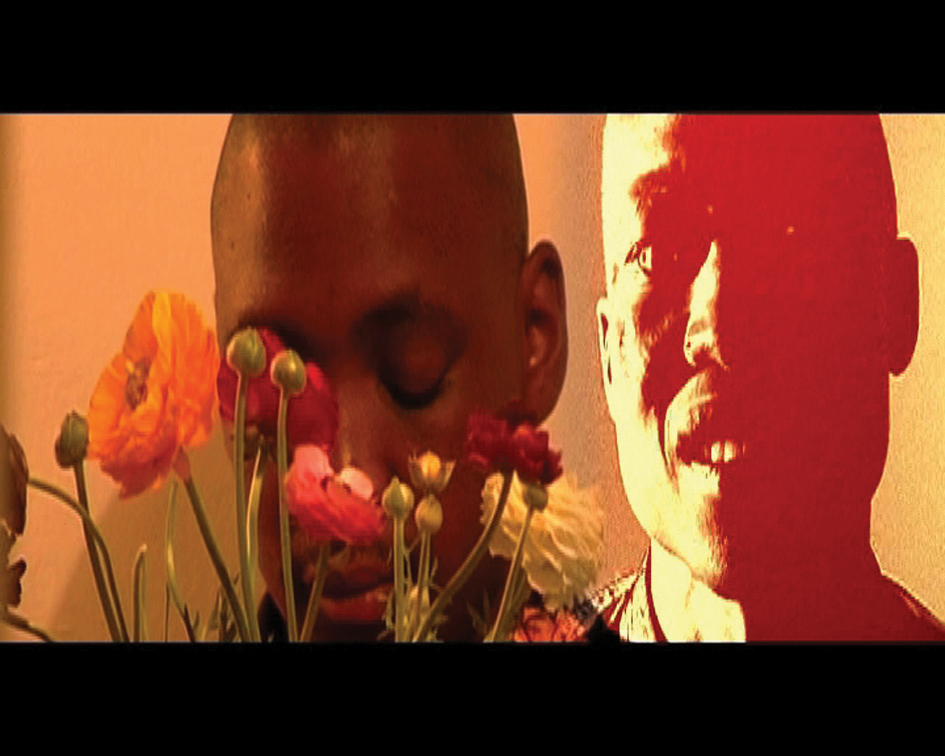
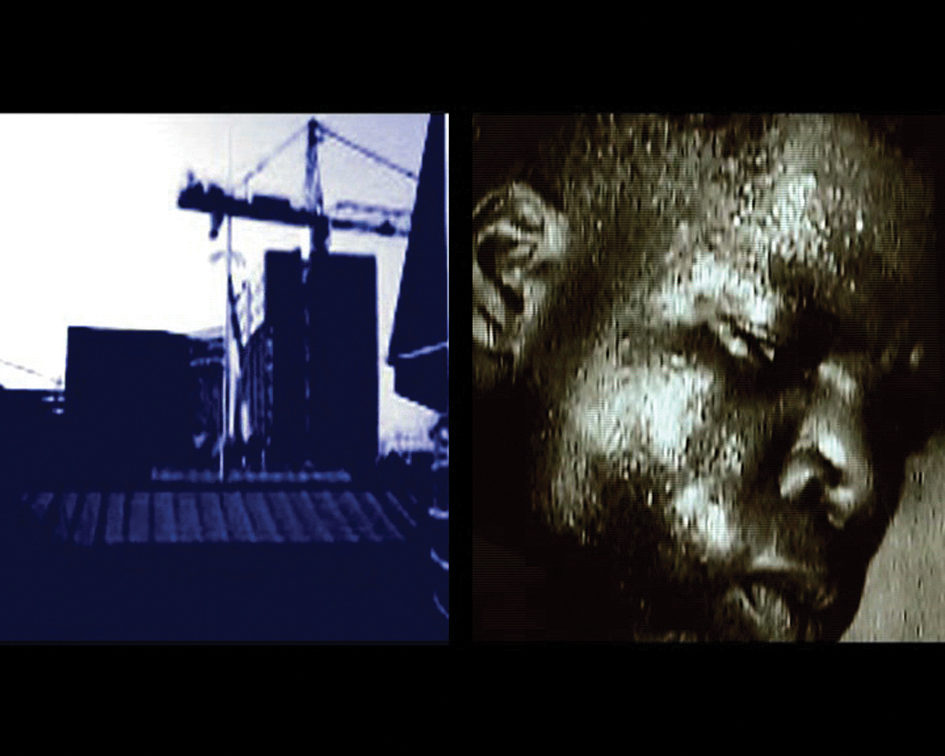
Kgafela oa Magogodi often uses the city as a vehicle or a metaphor through which to offer social and political commentary. Itchy City deals explicitly with the tensions between the promise and allure of the ‘golden’ city and its grim and often bleak reality. Magogodi’s circulation of capital is observed through the two stark experiences of the haves and the have-nots.
every tom dick and pipi with cash gets their kuku in the city of golden wishes beggars ride horses of small change
uncle lease small change asseblief
itchy city lights kill the night not even god is bored riding the back of a hijack
(from Itchy City)
Magogodi’s strength as a practitioner is his ability to capture through live performance the sensory immediacy of the city. Analogous to the experience of live jazz performance, his stage play I mike what I like (inspired by Steve Biko) sets a tone for artists to embody the freedom of expression and the right to non-partisan representational politics. Politically charged and socially hard-hitting, his performance is a bricolage of inter-textual references that draw from the political history of the city, activist discourses, popular street expressions and the stratified geographies of Johannesburg.
babyjakes come in small packages they pack dynamites in their trumpet blows break down the walls of jericho’s temples biblical brimstone and fire in the city of cold blood flows cheaply like pavement tomatoes the streets are red rivers dead bodies and gold platted teeth five star smile in the face of a corpse’
(from Itchy City)
In my collaboration with Magogodi, the idea was to find a way in which the stage play could be realized as a film. The challenge was not simply to capture the immediacy of what a live performance offers but to seek an expressive visual language for representing the city. An expression not confined to a single representation, but one which captured the multi-faceted nature of the city’s geographies, while alluding to its historical anchor. Furthermore, a film could not simply be a visual representation of the poetic referents. An interpretative treatment of the poetry was necessary on my part to augment the layers of dynamic commentary on history, urban regeneration and urban decay that had befallen Johannesburg that are present in the poetry itself.
Jyoti Mistry: How do the images and commentary created through your poetry differ from the historical images of Johannesburg and how do you view this in relation to the gentrification initiative of the city?
Kgafela oa Magogodi: Those who want the city gentrified want to remove what they see as ‘filthy’ or ‘threatening’ elements. These days security personnel put strong surveillance over anyone with dreadlocks. The focus seems to be on combing out unwanted ganja-smoking Rastas (they are said to smoke ganja at the slightest spiritual provocation; and the lingering smoke of their holy herb disturbs other people’s peace). They gentrify for the gentry of our times. A culture of the gentry is upon us. Gentry poetry. Gentry theatre. Gentry curators. Maybe this explains the things that take place on their stages … They love noble savages. Generally, blackness is adored if it is brought forward by the jiving native. It is safe (for them). If a native can jive, the fame of the auction-block stages awaits them. Celebrated black culture is, mostly: jive talk, jive walk, jive ass. It is strictly-come-jiving-time. It is Jika-majika time. No straight walk. No straight talk. People tend to jika-jika when serious dialogue must be held. Gamakhulu Diniso types are not really welcome. And I am not saying that people must stop jiving. There are those who believe that jiving is our culture, and who am I to differ? You probably remember the Radio Metro advert: ‘what makes you black?’ they asked. And the answer was a huge ghetto-blaster and loud music. You can call it ghetto-fabulous blackness. Yet, I think that there’s more to blackness than jiving. National television stations are best at promoting the jive aspects.
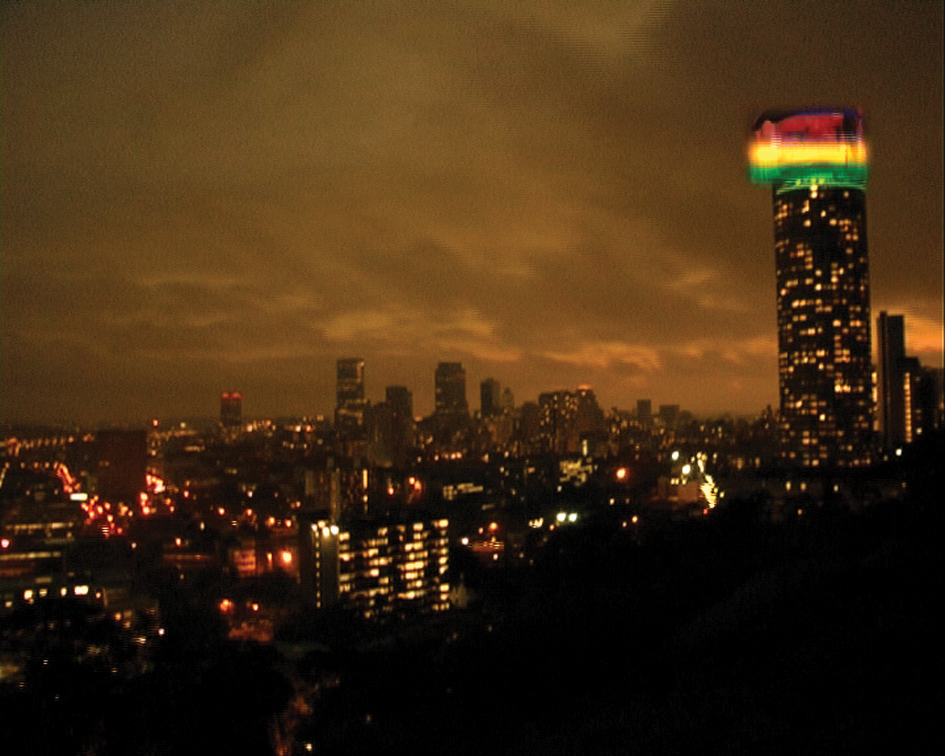
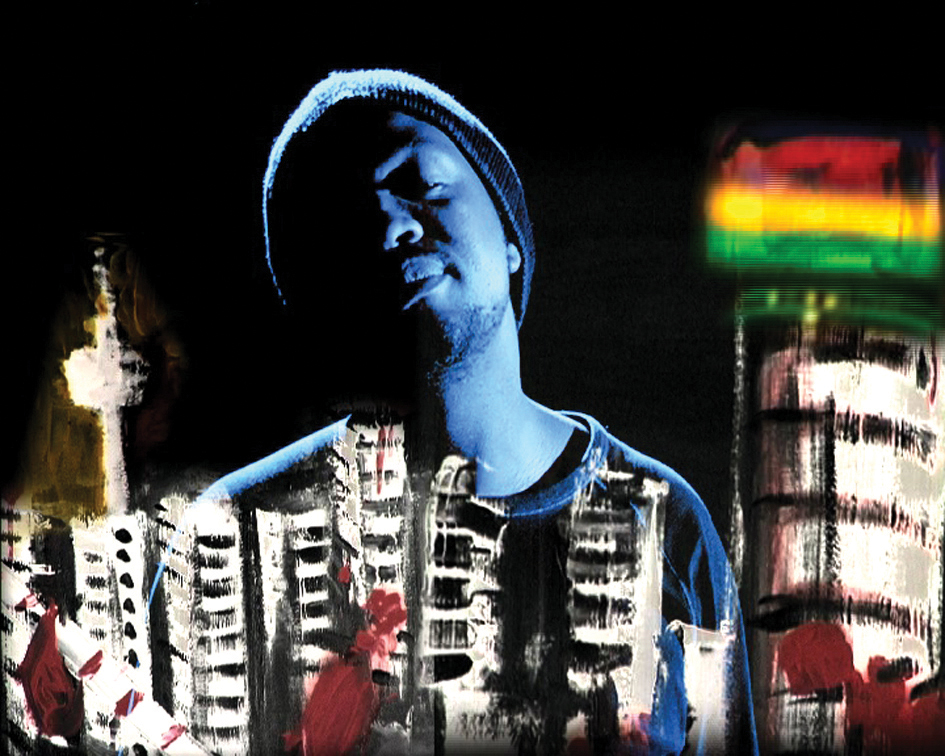
The promotion of jive culture is rife. Around the world, they discourage, even frame or defame, black people who refuse to jive for the gentry … Maybe history will raise questions about gentrification in the field of the arts. The curators of cultures will have to answer.
By using action paintings created by Musawenkosi Xokelelo during various performances, the film version relies strongly on the bricolage idea as a visual trope. Thus, through an integrated play between Magodogi’s spoken utterances, his performance itself, the mediated images produced by Xokelelo’s paintings, and the visual landscape built through the film layers, the representation of the city takes the form of not just a single experience but what Mikhail Bakhtin describes as heteroglossia: the derivations of meaning of texts based on contextual frameworks. Not just as the written (spoken) text but in the context of the live performance and in the context of the film, each mediated form inscribes a new subjective experience of the city.
Michel de Certeau, in the chapter ‘Walking in the City’ in his study The Practice of Everyday Life (De Certeau 1984), describes the importance of navigating the city on foot to fully understand its spatiality on an individual level. Organised by planners to produce one set of functionalities, it produces a myriad of other possibilities for the individual who works through their own, self-determined movement through space.
in small street you soak up the sounds of hustlers and hawkers selling secret socks starters packs and ama-empty empty cassette two for five rand ama-empty cassette
(from Itchy City)
For Magogodi navigating the city, with its inhabitants from all parts of Africa, is what speaks simultaneously to the vitality and the violence of contemporary Johannesburg. While the city offers itself up to be explored and navigated, it is also deeply stratified and these circuits of inclusion and exclusion lead to violent ructions.
Kgafela oa Magogodi: Johannesburg is historically ‘the city of the white man.’ We hope it has changed. Pass laws are now applied to Africans from the rest of the continent. The darker you are the more ‘illegal’ you look. Who bothers foreigners who look ‘legal’? Is it a Pan-African city in which the whiter or lighter you are, the more ‘legal’ you look.
The idea of a Pan-African City is tricky. What does it mean? Is it because there are so many African people impacting on the city’s temperament? Do these Africans beat drums? What is a Pan-European City like? Is it like Cape Town? Is Durban Pan-Indian? Back to Johannesburg; there is the Oriental Plaza in Fordsburg for Indian businesses. There’s Chinatown around Bruma Lake. Is it about ownership? Africans own which part of the city? Africans are either struggling to pay the rent or they trade from street pavements. Is this what we mean by Pan-African spaces? … Africans always looking out for police … Police always raiding ‘illegal’ African vendors… I really need to be advised about the meaning of a Pan-African City. This is probably the question I was grappling with in Itchy City:
sobukwe’s flock grow cabbages and sweet potatoes on street pavements to feed clothe and school the children school the children teach them to walk on fire who says the fire is fictitious it’s a furious figment of the city’s madness we point fingers at Nigerians but who is shooting poison in the arms of wingless angels heaven help us.
There is a poignant tension in Itchy City that captures on the one hand the textures of the city as they can only be experienced from walking it and absorbing its signs and language, while on the other hand, those that design and plan the urban regeneration view it from a distance. In the second instance the city is reproduced in a panoptic fashion as described by Michel Foucault through surveillance, observation and regulation (Foucault 1984).
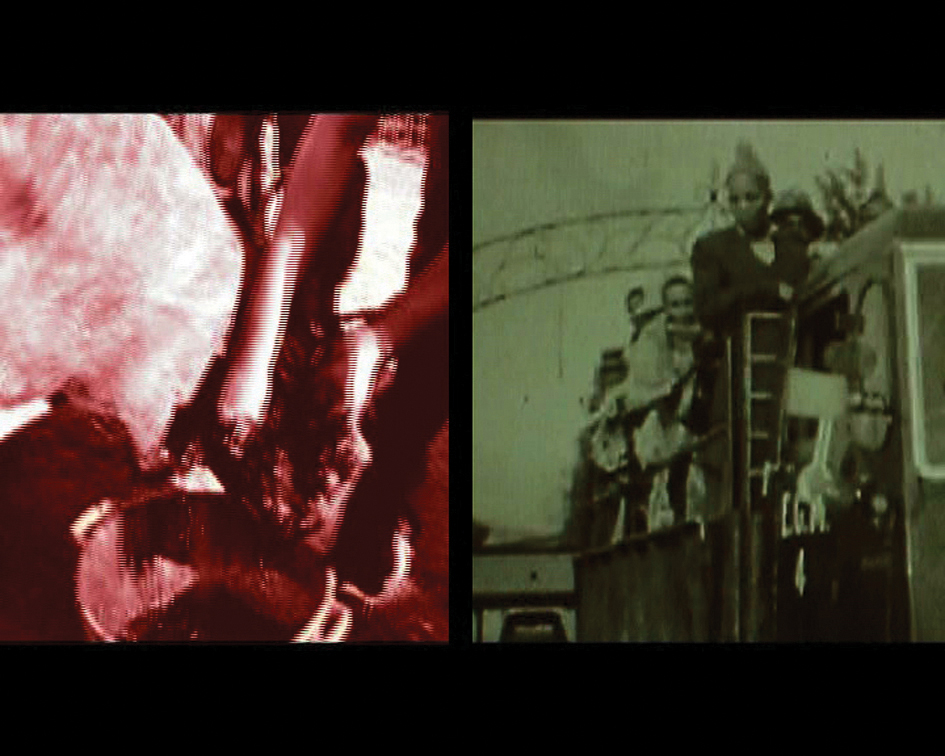
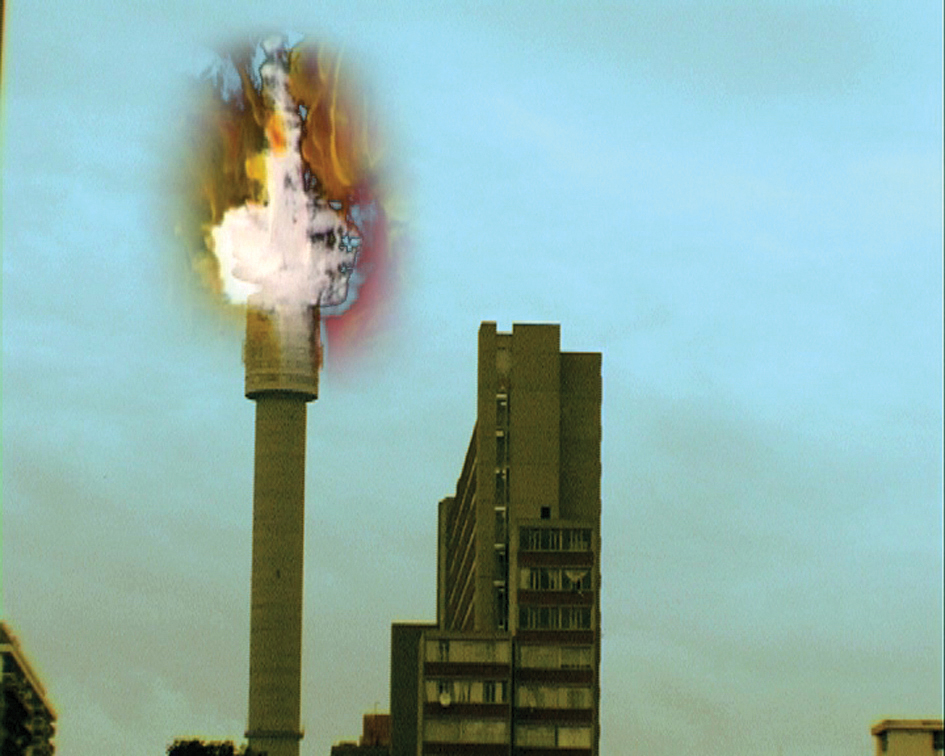
at least us climb to the top of pyramid schemes before police tear down these dreams
Will we escape these ulcers of fires inside us ulcers of fires eating up the bowels of our poor yet television fables say that ‘we are one’ but we are the ones who know the itching soul of the city
(from Itchy City)
The installation of closed-circuit television in downtown Johannesburg further attests to the regulation and policing of society that is strongly critiqued in Magogodi’s poetry. Similarly, in If this be a City Mntambo’s lonely man spends time observing the city from a distance. He seems almost incapable of entering it, choosing instead a pair of binoculars from which to watch it. At one point, it seems as if he is waiting for someone to arrive; he glances down over the balcony, anticipating or perhaps contemplating jumping off the building.
Nduka Mntambo: This distance is very central to my enquiry about the representation of Jo’burg in contemporary scholarship. Will it not make more sense to have the central character walking the streets of Jo’burg, interacting with the myriad of people of his city instead of his preoccupations of degraded memories and fantasies? Our central character, towered in his panopticon, studies possibilities and regrets and is comfortably wrapped in his ennui. It is the negation of the day-to-day experiential value of the city that my film seeks to highlight as a poverty of our scholarship.
Issues of gender and sexuality are perhaps some of the most hotly debated concerns for artists representing the African urban experience – primarily to counter some of the stereotypes of African masculinities, and secondly to challenge more rural assumptions made about women’s positions in society; the city is seen as a place that offers the possibility of redefining expressions of gender and sexuality.
Kgafela oa Magogodi: Sexuality is an important aspect of identity and it must be addressed alongside phenomena such as race and class. It is also important to converse about diseases that plague the nation, whether they are physical ailments or emotional traumas.
Akin Omotoso: Gender politics in the country are problematic and events like the woman that was assaulted at the taxi rank for wearing a mini skirt are continual reminders of the ugly side of this city.
Jesus and the Giant, Akin Omotoso’s short film, brings a wholly different presence to the city of Johannesburg. While the women in If this be a City are desired, and the centre of memories of love and longing, this short film produced through a series of still images attests to the violence in the city that is inscribed by a gendered politics. Mary (a black woman) seeks retribution from Jesus (a black woman) for the brutal and systemic beatings she experiences from her husband The Giant (a black man). In another context I have addressed the issues of racialising historical characters in this film (Mistry 2008). But for the purposes of this analysis I am concerned with the way in which the film strongly locates gendered violence in an urban context.
Akin Omotoso: Johannesburg is a violent city and I wanted to also create the idea that violence surrounds us daily so hence the slaughter of the cows at the taxi rank. The fact that Mary runs naked in the street bleeding and no one helps her and Jesus walks with a baseball bat and no one stops her, reflects the naturalising of this violence. This aspect of the city needed to be reflected in the film.
The opening of the film captures Jesus in quiet meditation, observing in her inner eye the violence of the city. The brutality is set up immediately through the use of close-up shots of cattle heads being skinned and chopped.
Jyoti Mistry: In a highly energetic and charged sequence Jesus runs through the streets. What aspects of the city did you want to show in this sequence and how did you decide what was important to reveal about the specificities of Johannesburg?
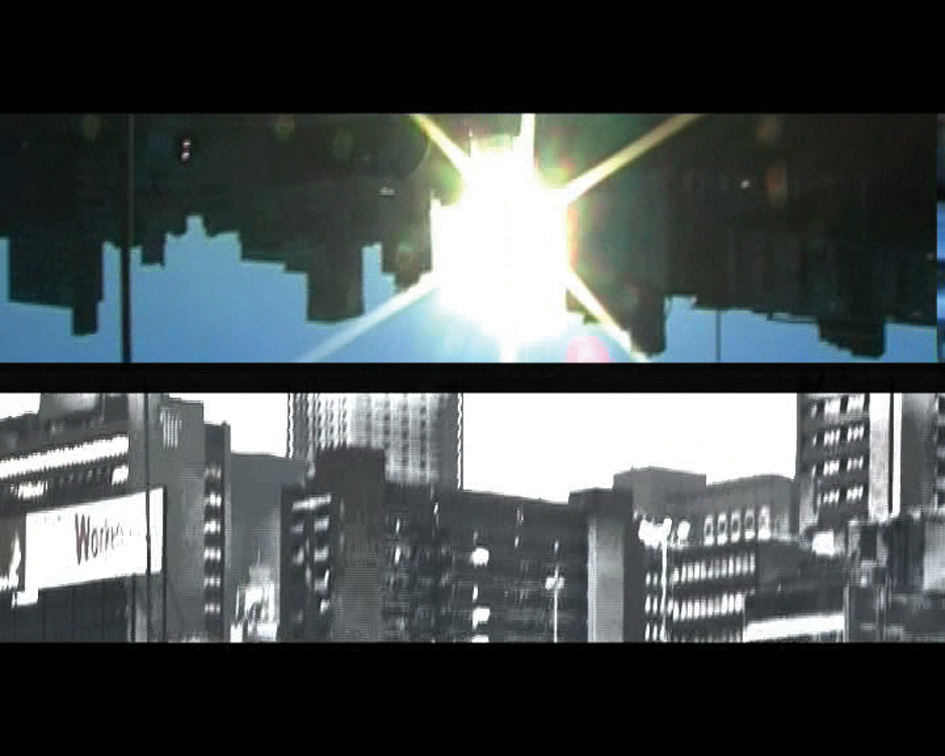
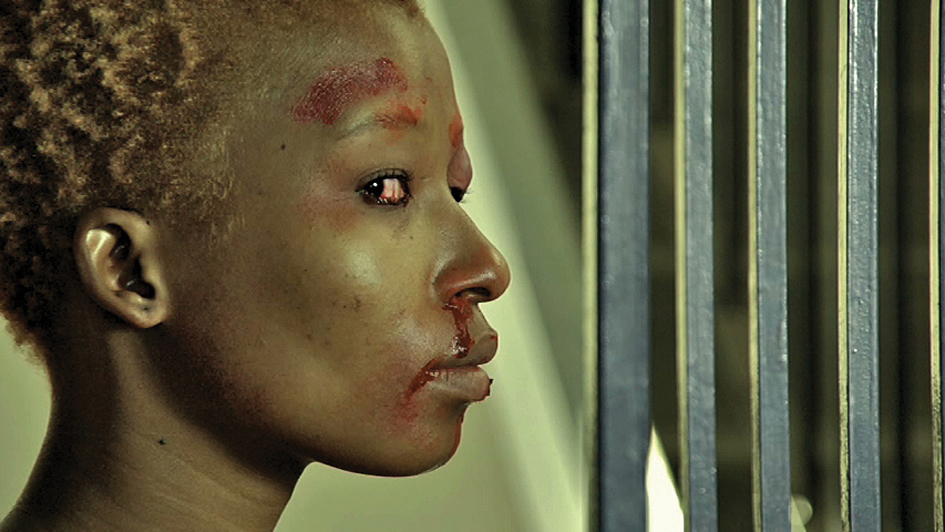
Akin Omotoso: Jesus was undecided as to whether to take revenge or not so she roams the city thinking about what she is going to do. I decided that she should do her main trek down Rockey Street and because of the style of shooting we were able to just shoot her walking casually. The choice of that street worked because it was alive and vibrant in ways that we couldn’t have imagined. She also runs through the pigeons. The pigeons are a recurring motif in the film and I have always found that whenever I drove past that part of town I knew I wanted to shoot a character running through the pigeons. It represented Jesus coming out to the freedom of the city but also that she still has a task to do.
Later in the film, when Jesus avenges Mary, the sequence intercuts between heads being chopped, Jesus beating The Giant with a baseball bat, and close-ups of Mary writhing in pain from her bruises. When Jesus accomplishes the retribution, she looks over the city, in a single panoramic view shot on 35 mm film to juxtapose with the fast, rhythmic edit of the stills images that preceded it – social balance is restored. Jesus is the master of the city as she watches over it from her lofty vantage point.
But it is not that simple. Omotoso complicates the message by showing that Jesus as a woman is neither tolerant of violence against women nor will she allow a city to rest without assuming responsibility for the violent treatment of women.
As she looks over the city Jesus says, ‘I have come with a sword, think not that I come in peace.’
To reveal the unconscious of a city, we need to track the visible marks of the passage of time and the various lines of flight that symbolise the culture of a place. (Mbembe 2004: 404)
In order to fully grasp the layers of a city, it is vital that art practice be used as an equally important marker to reveal the multiple meanings and experiences of the city. While history, architecture and urban geographies offer a material mark for the passage of time, it is the visceral that captures the conscious and unconscious experiences of the city. It is by walking, navigating, observing and surveying the city that artists produce new meanings about it that may offer contradictions or complementary positions to more scholarly positions on the city. These three practitioners, through their distinct and disparate practices, create new and evolving vocabularies in order to capture a visceral experience of their Johannesburg that offers entry points to a culture of place.
References
De Certeau M (1984) The Practice of Everyday Life. Berkeley: University of California Press
Foucault M (1984) Panopticism. In P Rabinow (ed.) The Foucault Reader. London: Penguin Books
Koolhaas R (1994) Delirious New York: A Retroactive Manifesto for Manhattan. New York: Monacelli Press
Mbembe A (2004) Aesthetics of Superfluity. Johannesburg, the Elusive Metropolis. Public Culture 16(3)
Mbembe A & Nuttall S (2004) Johannesburg, the Elusive Metropolis. Public Culture 16(3)
Mistry J (2008) Jesus and the Giant: A feminist challenge through the use of violence. Africultures: Feminism in Africa and the Diaspora 74
Murray M (2008) Taming the Disorderly City. Cape Town: UCT Press
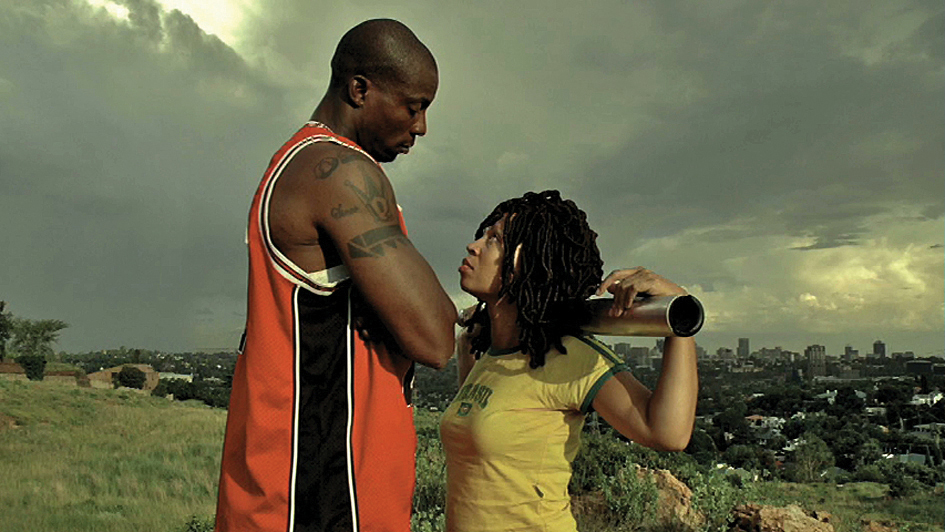
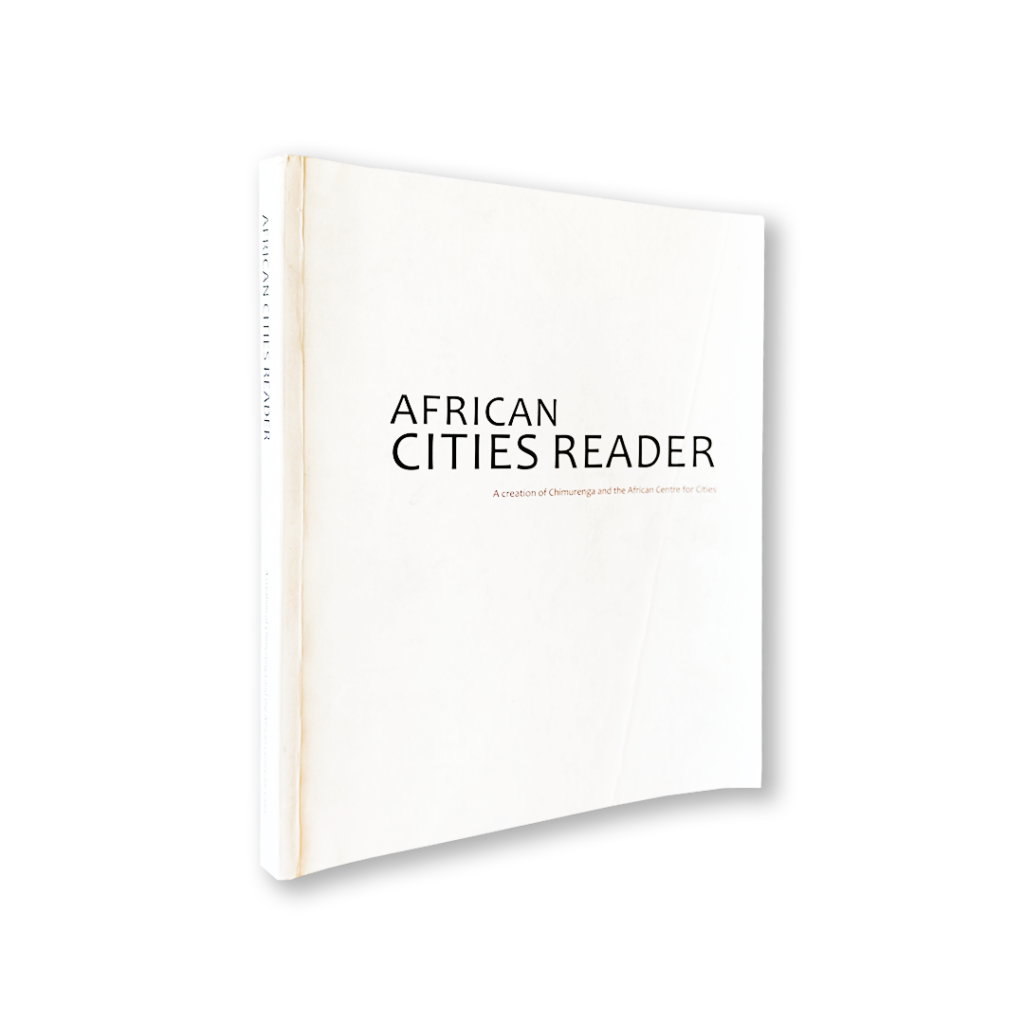
This story, and others, features in African Cities Reader I: Pan-African Practices (March 2010). The African Cities Reader series brings together contributors from across Africa and the world to challenge the prevailing depiction of urban life on the continent and redefine cityness, Africa-style.
To purchase available copies of African Cities Reader, head to our online shop.
This article and other work by Chimurenga are produced through the kind support of our readers. Please visit our donation page to support our work.
